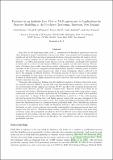| dc.contributor.author | McNamara, David D. | |
| dc.contributor.author | Nicol, Andrew | |
| dc.contributor.author | Archibald, Garth | |
| dc.contributor.author | Townend, John | |
| dc.contributor.author | Massiot, Cecile | |
| dc.date.accessioned | 2017-08-11T12:53:09Z | |
| dc.date.available | 2017-08-11T12:53:09Z | |
| dc.date.issued | 2014-09-16 | |
| dc.identifier.citation | Massiot, Cecile, McNamara, David D., Nicol, Andrew, Archibald, Garth, & Townend, John (2014). Fractures in an Andesite Lava Flow at Mt Ruapehu and its Implications for Fracture Modelling in the Rotokawa Geothermal Reservoir, New Zealand Paper presented at the 34th GOCAD Meeting Nancy, France. | en_IE |
| dc.identifier.uri | http://hdl.handle.net/10379/6708 | |
| dc.description.abstract | Fluid flow in the high-temperature (300 C), andesite-hosted Rotokawa geothermal reservoir (Taupo Volcanic Zone (TVZ), New Zealand) is largely controlled by fractures and faults but their geometries are still poorly understood. The aim of this study is to measure and derive geometric parameters characterising fractures in andesitic formations in order to use these as input for dis-crete fracture network models (DFN) and predictive fluid flow models of the Rotokawa geothermal reservoir. We make use of two complementary fracture datasets. (1) The fracture geometry in-trinsic to andesitic formations are studied on outcrops at Mt Ruapehu (TVZ volcano), with the measurement of c. 200 fractures along a 100 m long scanline, and the acquisition of a Terrestrial Laser Scanner (TLS) scan acquired over the entire outcrop. (2) Fracture orientation, width and spacing are determined for three acoustic borehole televiewer (BHTV) logs and 33 m of cores from the Rotokawa Geothermal Field. Two types of fractures are observed at the Mt Ruapehu outcrop. The majority of fractures form sub-vertical cooling joints. The TLS scan samples six dip directions suggesting an hexagonal section typical of basaltic lava flows. The scanline survey did not fully sample the six directions. The preliminary analysis of fracture length on the scanline survey highlights the high degree of fracture connectivity and a weak spatial clustering. A subset of the fractures are sub-horizontal, highly clustered and are aligned with possible changes of crystallinity, viscosity and flow banding within the flow. Further analysis is required to make firm conclusions about the fracture length and spacing. Fractures are conchoidal which enhances the fracture linkages, which cannot be easily quantified from scanline surveys and will be evaluated on the TLS scans. The BHTV and core analysis reveals that fractures within the reservoir are predominantly steeply dipping and NE SW-striking, parallel to the trend of the maximum horizontal compressive stress (S Hmax) and the rift axis. Fractures in the reservoir are preferentially oriented with respect to the in-situ stress and the tectonic faults but may be locally inherited from cooling joints and fractures associated with the internal fabric of the lava flows. BHTV logs indicate that the 8 50 mm wide fractures follow an exponential distribution. The log-normal, power-exponential or power-law distributions have similar likelihoods for fracture spacing of 0.005 50 m. Low spacing are best fitted by either an exponential, gamma or power-exponential distribution. This change at c. 1 m spacing may correspond to the threshold at which fracture interaction occurs. The lithological controls on the fractures is observed at both the outcrop and core scale, with fracture being less numerous and more tortuous in breccias than in massive lava. The breccias are typically more permeable than the massive interior, and offer lateral and vertical connectivity in reservoirs. Breccias also affect the propagation of the fractures due to their heterogeneity. Integrating these observations into fracture models will be fundamental to the prediction capability of the fracture models of the Rotokawa andesitic reservoir. Observations made at Ruapehu and Rotokawa have wide implication for the successful development of geothermal resources in volcanic-hosted geothermal reservoirs. | en_IE |
| dc.format | application/pdf | en_IE |
| dc.language.iso | en | en_IE |
| dc.publisher | Le Consortium Gocad | en_IE |
| dc.relation.ispartof | 34th GOCAD Meeting | en |
| dc.rights | Attribution-NonCommercial-NoDerivs 3.0 Ireland | |
| dc.rights.uri | https://creativecommons.org/licenses/by-nc-nd/3.0/ie/ | |
| dc.subject | Fracture geometries | en_IE |
| dc.subject | Andesites | en_IE |
| dc.subject | Mount Ruapehu | en_IE |
| dc.subject | New Zealand | en_IE |
| dc.subject | Fracture modelling | en_IE |
| dc.subject | Rotokawa Geothermal Field | en_IE |
| dc.title | Fracture geometries and processes in andesites at Mt Ruapehu, New Zealand: implications for the fracture modelling of the Rotokawa Geothermal Field | en_IE |
| dc.type | Conference Paper | en_IE |
| dc.date.updated | 2017-07-22T12:08:23Z | |
| dc.local.publishedsource | https://lecoledegeologie.wordpress.com/2014/09/05/34th-gocad-meeting/ | en_IE |
| dc.description.peer-reviewed | non-peer-reviewed | |
| dc.contributor.funder | |~| | |
| dc.internal.rssid | 11992000 | |
| dc.local.contact | David Mcnamara, -. - Email: david.d.mcnamara@nuigalway.ie | |
| dc.local.copyrightchecked | Yes | |
| dc.local.version | PUBLISHED | |
| nui.item.downloads | 159 | |


